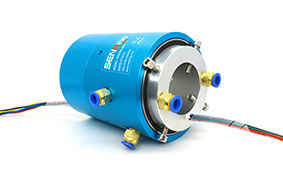How do you control the speed of a slip ring motor?
The speed of a slip ring motor can be controlled by adjusting the voltage supplied to the rotor circuit. By changing the voltage, the amount of current flowing through therotor circuit can be altered, which in turn changes the electromagnetic field produced by the rotor and affects the speed of the motor. Additionally, some slip ring motors may
have a variable resistor or a thyristor control system that can be used to regulate the speed of the motor.
The speed of a electrical slip ring manufacturers can be controlled using various methods, each offering different levels of precision and control. Here are some common
techniques for controlling the speed of a slip ring motor:

1. External Resistance Method:
In this method, external resistance is added to the rotor circuit to control the speed of the motor. By varying the resistance, the rotor current and hence the motor's speed can be
adjusted. However, this method is not very efficient due to the power dissipated in the resistors.
2. Rotor Rheostat Control:
A variable resistor (rheostat) connected to the rotor windings allows for manual speed adjustment by changing the rotor circuit resistance. While simple, this method is less common
nowadays due to its inefficiency and lack of precise control.
3. Slip Power Recovery:
By employing electronic controllers, it's possible to recover slip power from the motor and feed it back into the supply system. This method offers better energy efficiency compared to
external resistance control but requires more complex control systems.
4. Variable Frequency Drive (VFD):
One of the most common modern methods involves using a VFD to control the speed of the slip ring motor. VFDs adjust the frequency and voltage supplied to the motor, thus regulating
its speed. This method provides precise control and high energy efficiency, making it widely used in various industrial applications.
5. Electronic Soft Starters:
Soft starters gradually ramp up the voltage supplied to the motor, reducing inrush current and providing a smooth start-up. While not directly controlling speed during operation, this method
ensures controlled acceleration and reduces mechanical stress on the motor.
6. Synchronous Motor Control:
In some cases, slip ring motors can be operated as synchronous motors by supplying DC excitation to the rotor windings. By adjusting the excitation, the motor's speed can be controlled
within certain limits, offering another method for speed regulation.

Factors Influencing Method Selection:
Precision Requirement: The level of precision required in controlling the motor's speed.
Energy Efficiency: Considerations regarding energy consumption and the need for efficient control methods.
System Complexity: Assessing the complexity of the control system and its impact on overall operational requirements.
Cost and Maintenance: Evaluating the cost and maintenance implications of each speed control method.
Selecting the appropriate speed control method for a through hole slip ring with flange should take into account these factors, as well as the specific operational and performance
requirements of the motor within its intended application.
For more details on slip ring products, please view :https://www.senring.com/electrical-slip-rings/
FAQ questions:
1.Does wound rotor motor need slip ring and brushes?
2.What does a high rating slip ring induction motor use?
3.What are the drawbacks of slip rings and carbon brushes?
4.What does a high rating slip ring induction motor use?
5.What is capsule slip ring and is used for?

 RESOURCES
RESOURCES GET A QUOTE
GET A QUOTE





